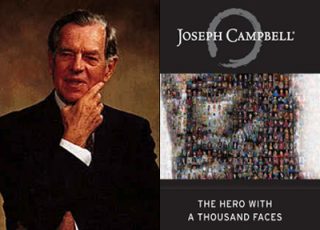In my previous post, I made the case that marketers are more effective when telling stories because it satisfies a fundamental human desire. In this post we’ll take a look at the history of The Hero’s Journey’s narrative framework.
Story telling predates writing; it has been with us since the dawn of humanity. However, it’s only relatively recently that anyone explored how or why we need to tell stories. At the beginning of the 20th century, Sigmund Freud and Carl Jung were pioneering the field of psychology and uncovered important truths about the human psyche; storytelling gives the present meaning and helps make sense of the world we live in. They introduced the concepts of a collective unconscious and archetypes.

In the 1930’s and 40’s a professor at Sarah Lawrence College named Joseph Campbell taught an introductory course on mythology. His research led to the publication of The Hero With a Thousand Faces, a treatise on storytelling across cultures. Influenced by many of Jung’s ideas, Campbell’s research showed similarities in mythology across cultures. He claimed that these myths are actually different versions of one underlying eternal theme, which he called the ‘mono myth.’ In the mono myth, there is a hero character that goes on a journey, encountering several archetypical characters along the way.
Here are the steps of the Hero’s Journey outlined by Campbell:
- Ordinary World – The Hero begins in an unremarkable world of normalcy.
- Call to Adventure – Our Hero receives a call to head off into the unknown.
- Refusal of the Call – Frequently, the Hero is reluctant to answer the call. This could be due to fear, insecurity, or other reasons.
- Meet the Mentor – The Hero meets a supernatural or spiritual guide.
- Cross the Threshold – This is the point where the Hero crosses from his/her ordinary world into the unknown.
- Tests, Allies, Enemies – The Hero must endure a series of tests or challenges to begin their transformation.
- Approach – Setbacks occur, sometimes causing the Hero to try a new approach or adopt new ideas.
- Central Ordeal – The Hero encounters a major obstacle or hurdle.
- The Reward – The Hero survives death, and earns a reward or accomplishes his/her goal.
- The Road Back – The Hero begins his/her way back to their ordinary world.
- Resurrection – A final test, where the Hero must summon all of his/her knowledge.
- Return With the Elixir – The Hero returns home and applies their new found knowledge or power.
Without meaning to, Joseph Campbell wrote a how-to guide for screenwriters. The Hero With A Thousand Faces became tremendously influential for Hollywood writers who employed the framework to craft plot lines, most notably with George Lucas and Star Wars. In fact, George Lucas claims that without Joseph Campbell, he would “…still be writing Star Wars today.”
Watch a young George Lucas give thanks to Joseph Campbell:
What does this look like in practice? Here’s how Star Wars maps to the Hero’s Journey:
- Ordinary World – Luke at home
- Call to Adventure – Leia’s message
- Refusal of the Call – Luke can’t leave because he has to help with the harvest
- Meet the Mentor – Obi-wan rescues Luke from the sand people
- Cross the Threshold – Luke escapes Tatooine
- Tests, Allies, Enemies – Lightsaber practice, Han and Chewie, stormtroopers
- Approach – Luke and allies move towards the Death Star
- Central Ordeal – They free the Princess
- The Reward – They capture the Death Star schematics
- The Road Back – Death Star has moved closer to the Rebel camp
- Resurrection – Luke destroys the Death Star by sacrificing part of his old self (his dependence on machines)
- Return With the Elixir – They are rewarded with medals
Today, the Hero’s Journey framework is everywhere. It is so prevalent in Hollywood blockbusters that it is difficult to find a large studio backed film that doesn’t follow the Hero’s Journey closely. Films like The Matrix, Finding Nemo, The Incredibles, and many, many, more all map closely to Campbell’s framework.
Read the next post, “How a Common Hollywood Screenwriting Technique Can Transform Your Marketing – Part 3 of 3: The Hero’s Journey For Brands.” (coming soon)
If you’d like to learn about the Hero’s Journey and how it can help your brand, download our free ebook here:
Or, watch our archived webinar:


